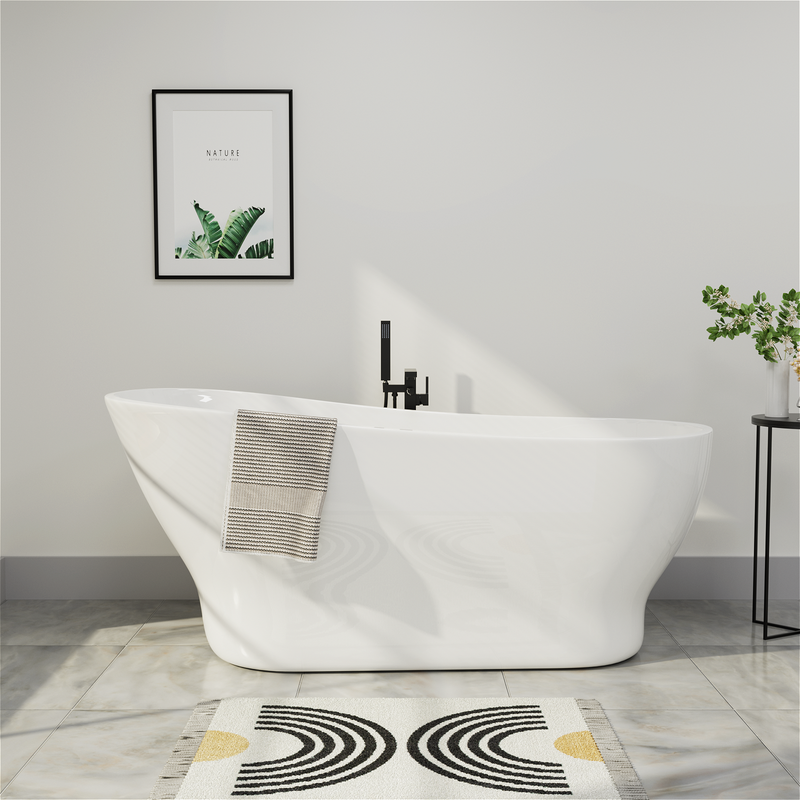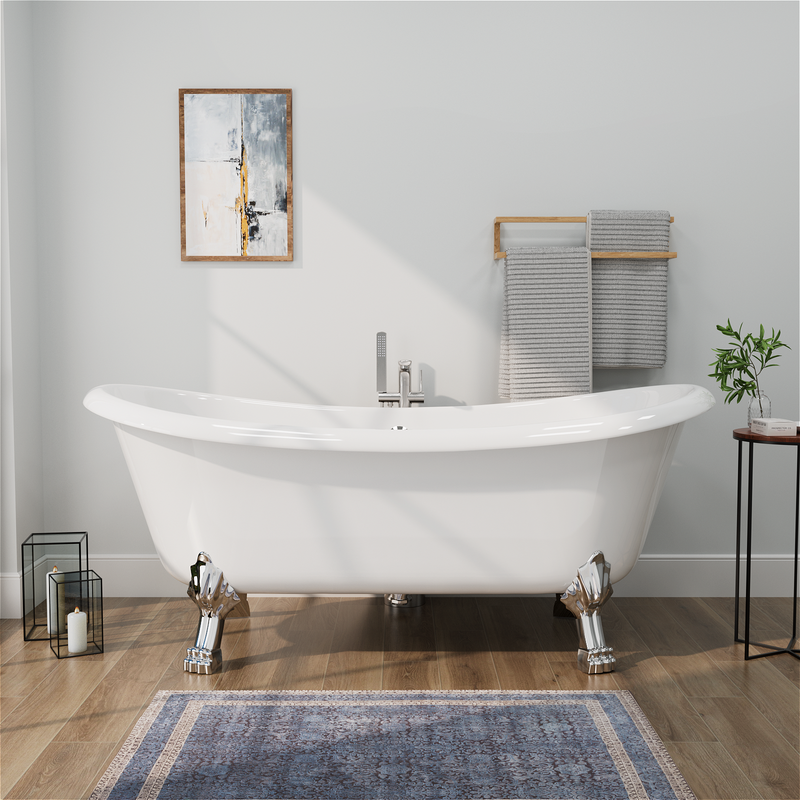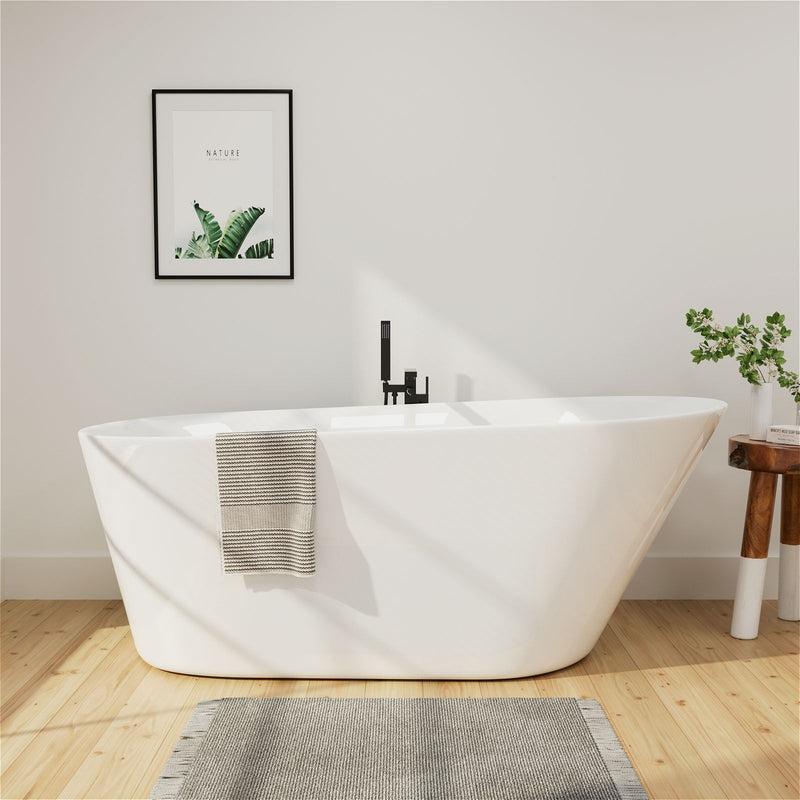Selecting a bathtub is a significant decision for any homeowner. It's not just about finding a place to get clean - it's about choosing a centerpiece for your bathroom that will serve you for years to come. The material of your bathtub fundamentally shapes your bathing experience, impacting everything from comfort and maintenance to cost and longevity. Among the various options available, acrylic and marble stand as two distinct choices with unique characteristics.
Acrylic tubs, made from synthetic materials, have gained popularity for their affordability and practical benefits. Marble tubs, crafted from natural stone, offer an undeniable sense of luxury and permanence. Understanding the differences between these materials goes beyond mere aesthetics, it involves considering your lifestyle, budget, and long-term home plans. This comprehensive guide will walk you through every aspect of acrylic and marble bathtubs, providing the knowledge you need to make an informed choice that you'll be happy with for years.
Appearance and Design Flexibility
The visual impact of your bathtub sets the tone for your entire bathroom. Both acrylic and marble offer distinct aesthetic appeals, but with different limitations and possibilities.
Acrylic bathtubs are manufactured from molded sheets of synthetic material, which allows for remarkable design versatility. They can be formed into virtually any shape or size, accommodating everything from compact corner units to sweeping freestanding designs. The color is integrated throughout the material, offering a wide range of hues from classic whites to contemporary tones. This manufacturing process enables acrylic tubs to mimic more expensive materials at a fraction of the cost. The surface of a quality acrylic tub features a high-gloss finish that maintains its shine for years with proper care.

Marble bathtubs are hewn from solid blocks of natural stone, making each piece uniquely patterned. The veining and color variations in marble ensure that no two tubs are exactly alike, offering a one-of-a-kind centerpiece for your bathroom. Marble tubs typically feature a polished finish that highlights the stone's natural characteristics, though honed finishes are also available for a matte look. The visual appeal of marble is undeniable - it brings an immediate sense of history, solidity, and luxury to any space. However, unlike acrylic, marble offers limited options for custom shapes beyond the standard rectangular, oval, or pedestal designs due to the constraints of working with solid stone.
Durability and Maintenance Requirements
When investing in a bathtub, understanding how it will withstand daily use and what it will require in upkeep is crucial for long-term satisfaction.
Acrylic bathtubs are known for their resilience and straightforward maintenance. The non-porous surface of quality acrylic tubs resists staining and makes cleaning relatively simple - usually requiring just a soft cloth and mild cleaner. A key advantage of acrylic is its forgiving nature regarding impacts, if scratched, the surface can often be repaired with a polishing compound to restore its original appearance. However, acrylic can be vulnerable to harsh abrasive cleaners, which may dull its glossy finish over time. It's also worth noting that while acrylic stands up well to regular use, its surface may show wear more readily than marble in high-traffic households.
Marble bathtubs offer exceptional longevity - properly maintained, they can last a lifetime. The stone is incredibly hard and resistant to surface damage under normal use. However, marble requires more specialized care than acrylic. Being a porous natural stone, marble must be professionally sealed upon installation and re-sealed periodically to prevent staining from bath oils, soaps, and minerals in water. Even with proper sealing, marble remains vulnerable to etching from acidic substances. Common bathroom products like certain shampoos, cleaners, or even citrus-based products can permanently damage the surface finish if spilled and not immediately wiped up. Unlike acrylic, repairing damage to marble typically requires professional restoration.
Comfort and Heat Retention
The bathing experience itself varies significantly between acrylic and marble tubs, particularly in how they feel to the touch and how long they keep water warm.
Acrylic bathtubs excel in immediate comfort. The material feels warm to the touch from the moment you enter, eliminating the initial shock of cold surface that can occur with other materials. This makes acrylic tubs particularly appealing in cooler climates or for those who prefer spontaneous bathing. Acrylic's natural thermal properties help retain heat reasonably well, allowing for extended soaks without constant hot water replenishment. The material itself is slightly yielding under pressure, providing a more comfortable seating and reclining surface than harder materials.

Marble bathtubs offer a distinctive sensory experience. The stone feels cool initially but gradually warms to body temperature during use, creating a unique interaction between bather and material. Where marble truly excels is in heat retention - the density and mass of stone keep water warm significantly longer than most other bathing materials. This superior heat preservation means your bathwater stays at your preferred temperature for the entire duration of your soak, creating an indulgent experience particularly valued during colder months. The solid, unyielding surface of marble provides a stable, grounding bathing experience that many enthusiasts find uniquely therapeutic.
Installation Considerations and Cost Analysis
The practical aspects of installing either an acrylic or marble tub involve significant differences in complexity, requirements, and overall investment.
Acrylic bathtubs present notable installation advantages due to their relatively light weight. A standard acrylic tub can often be installed without reinforcing the bathroom floor, making it suitable for upper-level bathrooms in multi-story homes. The lightness of the material also makes positioning and adjustment during installation more manageable, potentially reducing labor time and costs. From a cost perspective, acrylic tubs are significantly more budget-friendly both in terms of initial purchase price and installation expenses. The price advantage makes quality bathing experiences accessible to a wider range of homeowners without compromising on functionality or aesthetics.
Marble bathtubs require substantial structural consideration due to their exceptional weight. A typical marble tub can weigh hundreds of pounds empty, and when filled with water and a bather, this weight increases dramatically. Professional assessment of floor joists and potentially significant structural reinforcement are often necessary, particularly in homes not originally designed to accommodate such loads. Installation requires specialized equipment and expertise, adding to the overall project cost. The investment for a marble tub encompasses not just the substantial purchase price but also the custom installation requirements. This places marble tubs in the luxury investment category, with costs typically several times higher than acrylic alternatives.
FAQs
How does the cost of maintaining an acrylic tub compare to a marble tub over ten years?
Acrylic tub maintenance costs are relatively minimal, primarily involving routine cleaning supplies and occasional polishing compounds for minor scratches. Marble requires professional sealing every 1-2 years, specialized pH-neutral cleaning products, and potentially more expensive stain removal treatments. Over a decade, marble maintenance costs typically exceed acrylic's by several hundred dollars, not accounting for any significant repairs.
Can an acrylic tub be made to look like marble?
Yes, through advanced manufacturing techniques, acrylic can be finished with realistic marble patterns that closely mimic the look of natural stone. While these printed patterns won't have the depth or variation of real marble, they offer a convincing aesthetic alternative at a lower cost and with acrylic's practical benefits. Mokleba offers several designs that capture the marble appearance in durable acrylic.
Which material is better for households with children?
Acrylic is generally more practical for families with children. Its warm surface temperature is more comfortable for young skin, its slightly yielding surface is safer for accidental bumps, and its stain resistance stands up better to bath toys, crayons, and other products common in family bathrooms. The lower maintenance requirements also fit better with the demanding schedules of family life.
How long does each material typically last before needing replacement?
A quality acrylic tub typically provides 15-20 years of service before showing significant signs of aging, though many last much longer with proper care. Marble is essentially a lifetime product - with appropriate maintenance, a marble tub can last for decades and potentially generations.
Are marble tubs noticeably colder to enter than acrylic tubs?
Initially, yes - marble will feel cooler to the touch when first entering the bath. However, this difference becomes less noticeable once the tub is filled with warm water and the stone begins to absorb heat. Many marble tub enthusiasts appreciate this initial coolness as part of the sensory experience, particularly in warmer climates.
Can I install either type of tub on any bathroom floor?
Acrylic tubs can typically be installed on any properly constructed bathroom floor without reinforcement. Marble tubs require professional structural assessment first. The concentrated weight of a marble tub, especially when filled with water and occupied, may require additional floor joists, support beams, or other reinforcements, particularly in second-story bathrooms or homes with specific architectural limitations.
Which material holds its value better for home resale?
Marble tubs generally maintain a higher perceived value and can be a notable selling point in luxury homes. However, the return on investment depends on your local real estate market. Acrylic tubs in good condition are viewed positively in standard home markets as functional, modern fixtures. Well-maintained examples of both materials add value, but marble's premium positioning typically translates to better value retention.
Making Your Decision
Choosing between an acrylic and marble bathtub ultimately comes down to aligning the material's characteristics with your personal priorities, lifestyle, and budget. Acrylic offers practical advantages through its lightweight nature, warm surface feel, design flexibility, and lower maintenance requirements. It presents an excellent choice for those seeking comfort, convenience, and value. Marble provides unparalleled durability, superior heat retention, and a unique aesthetic presence that many find irreplaceable. It represents a long-term investment in luxury and permanence.
Consider how you use your bathroom today and how you might use it in the future. Factor in your willingness to perform regular maintenance versus your desire for natural materials. Be realistic about your budget, not just for the initial purchase but for long-term upkeep.





